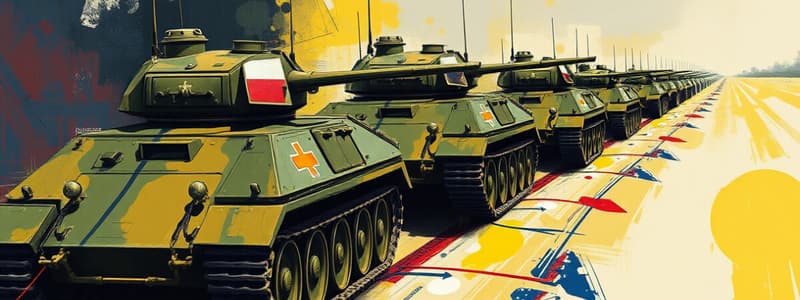Podcast
Questions and Answers
What is a primary advantage of line communication compared to radio communication?
What is a primary advantage of line communication compared to radio communication?
- It operates on lower frequencies.
- Requires fewer operators to manage.
- More flexible for use in mobile situations.
- It is more secure than radio communication. (correct)
Which of the following best describes a Trunk Circuit?
Which of the following best describes a Trunk Circuit?
- A direct connection between two telephones.
- A system using one or more exchanges. (correct)
- A communication line not needing exchanges.
- A system using only one exchange.
What does the term 'Crossing' refer to in the context of line communication?
What does the term 'Crossing' refer to in the context of line communication?
- The separation of cable types.
- Connecting multiple telephones in a circuit.
- Techniques used to navigate obstacles while laying wire. (correct)
- A method to enhance signal strength.
In what situation is line communication generally preferred for operators?
In what situation is line communication generally preferred for operators?
Which statement about the Local Battery (LB) Operation is accurate?
Which statement about the Local Battery (LB) Operation is accurate?
What is a characteristic of point to point circuits?
What is a characteristic of point to point circuits?
What is one disadvantage of line communication that can be inferred?
What is one disadvantage of line communication that can be inferred?
What role do operators play after laying line communication?
What role do operators play after laying line communication?
What is the recommended distance to keep overhead cables from power lines?
What is the recommended distance to keep overhead cables from power lines?
Which of the following best describes the correct procedure for an underground cable crossing?
Which of the following best describes the correct procedure for an underground cable crossing?
When conducting a recce for line laying, what is an important factor to consider regarding the weather?
When conducting a recce for line laying, what is an important factor to consider regarding the weather?
For railway crossings, which method is recommended if conducting a recce reveals no nearby bridges?
For railway crossings, which method is recommended if conducting a recce reveals no nearby bridges?
What aspect should be prioritized to ensure efficient line maintenance and repair?
What aspect should be prioritized to ensure efficient line maintenance and repair?
Where should labels for field wire positioning be placed?
Where should labels for field wire positioning be placed?
What is a significant risk when crossing cables through rivers?
What is a significant risk when crossing cables through rivers?
What is an essential consideration when planning the timing for laying the cable?
What is an essential consideration when planning the timing for laying the cable?
What should a recce commander avoid when planning a cable route?
What should a recce commander avoid when planning a cable route?
Which of the following types of cable crossings requires the most caution?
Which of the following types of cable crossings requires the most caution?
What is a major characteristic required for a cable used in communication?
What is a major characteristic required for a cable used in communication?
Which type of cable construction is best suited for short-duration communication?
Which type of cable construction is best suited for short-duration communication?
What is a disadvantage of using aerial cable for communication?
What is a disadvantage of using aerial cable for communication?
Which type of cable consists of a single copper wire with a light insulator?
Which type of cable consists of a single copper wire with a light insulator?
Why is underground cable preferred in areas of heavy traffic flow?
Why is underground cable preferred in areas of heavy traffic flow?
Which characteristic does Wire D-8 have?
Which characteristic does Wire D-8 have?
What is a significant challenge of line laying techniques?
What is a significant challenge of line laying techniques?
What type of cable is specifically used underwater?
What type of cable is specifically used underwater?
Which of the following is NOT a factor affecting line quality?
Which of the following is NOT a factor affecting line quality?
Wire W-3 is constructed primarily of which materials?
Wire W-3 is constructed primarily of which materials?
What is a key feature of a wire dispenser, such as MX-1302 A/B?
What is a key feature of a wire dispenser, such as MX-1302 A/B?
What does the term 'hardness' refer to in relation to a cable?
What does the term 'hardness' refer to in relation to a cable?
The type of reel that can roll 2.5 miles of wire is?
The type of reel that can roll 2.5 miles of wire is?
Which of the following statements about Wire Iron GI 300 Pond is correct?
Which of the following statements about Wire Iron GI 300 Pond is correct?
Flashcards
Importance of Line Communication
Importance of Line Communication
Line communication provides secure communication during military operations and defense, especially in harbor areas.
Static Communication Comfort
Static Communication Comfort
Static communication offers more comfort for operators than using radios.
Line Security and Maintenance
Line Security and Maintenance
Security and maintenance of communication lines after laying are a collective responsibility.
LB Operation
LB Operation
LB operation uses own batteries for telephone and exchange functions.
Signup and view all the flashcards
CB Operation
CB Operation
CB operation uses the exchange's battery exclusively.
Signup and view all the flashcards
Local Circuit
Local Circuit
A local circuit uses only one exchange point.
Signup and view all the flashcards
Trunk Circuit
Trunk Circuit
A trunk circuit connects multiple exchanges together.
Signup and view all the flashcards
Point to Point Circuit
Point to Point Circuit
A direct connection between two telephone sets without an exchange.
Signup and view all the flashcards
Advantages of Line Communication
Advantages of Line Communication
Immediate communication, security against weather, and support for simultaneous messaging.
Signup and view all the flashcards
Disadvantages of Line Communication
Disadvantages of Line Communication
Difficult initial setup, manpower-intensive, and hard to maintain during movement.
Signup and view all the flashcards
Characteristics of Cables
Characteristics of Cables
Cables should be strong, lightweight, low resistance, well-insulated, and flexible.
Signup and view all the flashcards
Factors Influencing Communication
Factors Influencing Communication
Factors include cable type, laying method, and quality of the power supply.
Signup and view all the flashcards
Assault Cable
Assault Cable
Single copper wire, non-recoverable, can be laid by aircraft.
Signup and view all the flashcards
Wire WD III
Wire WD III
Made in the USA, copper and steel, weighs 48 lbs per mile, withstands high pressure.
Signup and view all the flashcards
Wire D-8
Wire D-8
Poor insulation, similar structure to WD III.
Signup and view all the flashcards
Wire W-3
Wire W-3
Varied insulation durability, made in Pakistan, composition and quality may differ.
Signup and view all the flashcards
DR-5 Reel
DR-5 Reel
Holds up to 2.5 miles of wire, made of iron.
Signup and view all the flashcards
Wire Dispenser MX-1302 A/B
Wire Dispenser MX-1302 A/B
Canvas-made, supports rapid wire laying at high speeds.
Signup and view all the flashcards
RL-31 Reel
RL-31 Reel
Versatile reel for vehicle or ground mounting, holds multiple wires, braking mechanisms.
Signup and view all the flashcards
Ground Cable
Ground Cable
Cost-effective for short deployments, requires minimal digging.
Signup and view all the flashcards
Underground Cable
Underground Cable
Essential for heavy traffic areas, requires careful burial.
Signup and view all the flashcards
Aerial Cable
Aerial Cable
Best for overhead installations, ensures clearance from the ground.
Signup and view all the flashcards
Overhead Crossing
Overhead Crossing
Common near command posts and during troop movements.
Signup and view all the flashcards
Underground Crossing
Underground Crossing
Ideal for non-metallic surfaces, involves trenching methods.
Signup and view all the flashcards
Specialized Crossings
Specialized Crossings
Requires caution for railways and water bodies, ensuring insulation and labeling.
Signup and view all the flashcards
Line Duration Assessment
Line Duration Assessment
Assess whether the line is temporary or permanent.
Signup and view all the flashcards
Intelligence Reconnaissance (Recce)
Intelligence Reconnaissance (Recce)
Conduct intelligence reconnaissance (recce) to gather vital information.
Signup and view all the flashcards
Speed and Protection
Speed and Protection
Maintain speed and protection for quick adjustments and easy maintenance.
Signup and view all the flashcards
Labels
Labels
Important for identifying line sections and ensuring clarity.
Signup and view all the flashcards
Daily Inspections
Daily Inspections
Daily inspections and accurate records of line usage are necessary.
Signup and view all the flashcardsStudy Notes
Introduction to Line Laying
- Line communication is crucial for effective military operations, especially within the Armoured Corps.
- Ensures secure communication during defense and operations, particularly in harbor areas.
- Familiarity with line equipment is essential for quick and successful line laying.
Sequence Overview
- Part-1: General points, terminologies, advantages/disadvantages, characteristics of cables.
- Part-2: Types of cables, reels, and major parts involved in line laying.
Line Laying Techniques
General Points
- Static communication is more comfortable than radio for operators.
- Security and maintenance of lines post-laying are collective responsibilities.
- Line communication is primarily used in exercises and defense operations.
Terminologies
- LB Operation: Utilizes own batteries for telephone and exchange.
- CB Operation: Involves using exchange's battery only.
- Local Circuit: Utilizes one exchange.
- Trunk Circuit: Connects multiple exchanges.
- Point to Point Circuit: Direct connection between two telephone sets without an exchange.
Advantages and Disadvantages
- Advantages:
- Immediate communication once wires are laid.
- Secure against weather conditions.
- Allows simultaneous messaging.
- Disadvantages:
- Difficult initial setup and manpower-intensive.
- Hard to replace lines and maintain during movement.
Characteristics of Cables
- Cables should be strong, lightweight, low resistance, well-insulated, and flexible.
- Factors influencing line communication include cable type, laying method, and power supply.
Types of Cables
- Assault Cable: Single copper wire, non-recoverable post-laying, can be laid using aircraft.
- Wire WD III: Manufactured in the USA, consists of copper and steel, weight 48 lbs per mile, withstands high pressure.
- Wire D-8: Poor insulation, similar structure to WD III.
- Wire W-3 and Others: Varied insulation durability, made in Pakistan, composition and quality may differ.
Reels for Wire Management
- DR-5: Holds up to 2.5 miles of wire, made of iron.
- Wire Dispenser MX-1302 A/B: Canvas-made, supports rapid wire laying at high speeds.
- RL-31: Versatile reel for vehicle or ground mounting, capable of holding multiple wires and equipped with braking mechanisms.
Line Laying Techniques
Types of Line Constructions
- Ground Cable: Cost-effective for short deployments, requires minimal digging.
- Underground Cable: Essential for heavy traffic areas, requires careful burial techniques.
- Aerial Cable: Best for overhead installations, ensuring adequate clearance from the ground.
Crossings
- Overhead Crossing: Commonly used near command posts and during troop movements.
- Underground Crossing: Ideal for non-metallic surfaces, involves trenching methods.
- Specialized Crossings: Requires caution for railways and water bodies, ensuring proper insulation and labeling.
Essential Considerations for Line Laying
- Assess whether the line is temporary or permanent.
- Conduct intelligence reconnaissance (recce) to gather vital information on the environment.
- Maintain speed and protection during line laying to facilitate quick adjustments and easy maintenance.
Labeling and Maintenance
Labels
- Important for identifying specific line sections and ensuring operational clarity.
- Use consistent non-matching letters for formations.
Maintenance
- Conduct daily inspections and keep accurate records of line usage.
- Maintenance personnel should be skilled and equipped with necessary materials for repairs.
Studying That Suits You
Use AI to generate personalized quizzes and flashcards to suit your learning preferences.



